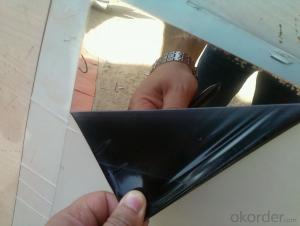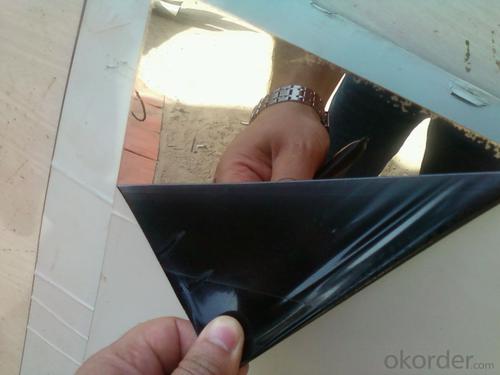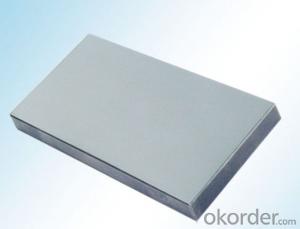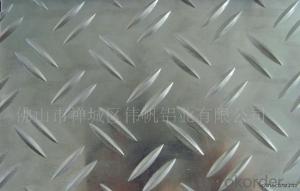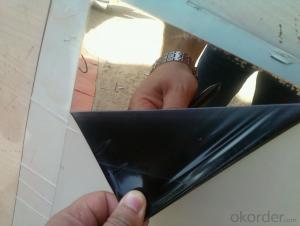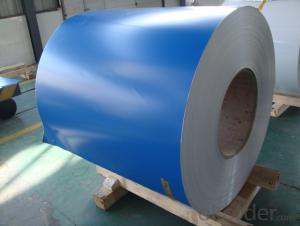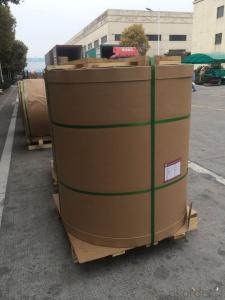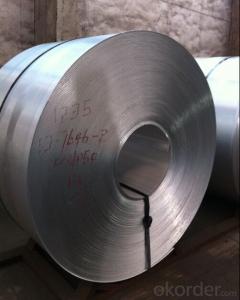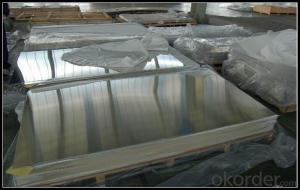Aluminum Mirrors Sheets - Cold Rolled & Hot Rolled Aluminum Plates at Best Prices
- Loading Port:
- Shanghai
- Payment Terms:
- TT OR LC
- Min Order Qty:
- 6 m.t
- Supply Capability:
- 200 m.t/month
OKorder Service Pledge
OKorder Financial Service
You Might Also Like
Specification
1.Structure of Product Description
Our aluminum sheet/plate/slab is widely used in the field of construction field and decoration field, etc.
There are many different grades, such as: 5000 series, 6000series, etc. The detailed grade are as follows: 1010, 1050,5052, 6061,6063,8011, etc.
The temper is include H24, H44,H112,H112, etc.
2. Main features of the product
a.Competitive price
b.Frist-Class Service.
3. Image.

4. Product detailed sizes:
1000mm*2000mm, 1250mm*2500mm,1500mm*3000mm, etc.
5. FAQ:
---Usually our standard is GB3880-2006 or others.
What is the width range?
---It is from 1000mm to 2500mm, etc.
What is the length range:
---It is from 2000mm to 6000mm, etc.
---Normally it is around 5 tons/each size.
How many tons did you export in one year?
---Singapore, Vietnam, Turkey,Canada, Fiji,UAE,etc.
---Normally they are aluminum sheet,mirror finish aluminium sheet, aluminum casting coil, etc.
- Q: Are aluminum sheets suitable for electrical enclosures?
- Yes, aluminum sheets are suitable for electrical enclosures. Aluminum is a lightweight and durable material that offers excellent conductivity and corrosion resistance. It also has good heat dissipation properties, making it ideal for enclosures that house electrical components. Moreover, aluminum is easy to fabricate and can be formed into various shapes and sizes, allowing for customization of the enclosure design. Additionally, aluminum sheets can be coated or anodized to enhance their resistance to environmental factors like moisture, dust, and chemicals. Overall, aluminum sheets provide a reliable option for electrical enclosures due to their electrical and mechanical properties, as well as their ability to protect sensitive electrical equipment.
- Q: Is it suitable to use aluminum windows in areas with cold weather conditions?
- <p>Yes, you can use aluminum windows in cold climates, but there are considerations. Aluminum is a good conductor of heat, which can lead to heat loss in cold weather. To mitigate this, insulated glass units and thermally broken frames can be used. These designs slow down heat transfer, making aluminum windows more energy-efficient in cold climates. Additionally, proper sealing and weatherstripping are crucial to prevent drafts and ensure the windows perform well in low temperatures.</p>
- Q: And isn't aluminum extremely bad for ones health?
- Antiperspirant does two things. It kills sanitizes the area so it kills resident bacteria that eat the oils and secretions in the skin and produce odor. The aluminum compounds plug the pores and prevent sweat secretion. But be careful, aluminum has been implicated in Alzheimers disease.
- Q: How is the coated aluminum mirror plate produced?
- 1) substrate material:First grade: aluminum magnesium alloy, while containing manganese, advantages of the material is the greatest antioxidant ability is good, at the same time because the content of manganese, so it has a certain strength and stiffness, is the most ideal material of smallpox. The performance of aluminum processing in the Southwest Aluminum Factory is the most stable in china.Second grade: aluminum manganese alloy, the strength and rigidity of this material is slightly better than that of Al Mg alloy. But its oxidation resistance is slightly lower than that of Al Mg alloy. Such as both sides of the protective treatment, basically to solve its antioxidant ability than aluminum magnesium alloy good shortcomings, domestic aluminum and aluminum processing of the most stable.Third grade: aluminum alloy, the manganese and magnesium content of the alloy is less. Therefore, its strength and stiffness are lower than that of Al Mg alloy and Al Mn alloy. As it is soft and easy to process, as long as it reaches a certain thickness, it can basically meet the basic flatness requirements of smallpox. But its antioxidant ability is obviously inferior to that of Al Mg alloy and Al Mn alloy. Moreover, it is easy to deform during processing, transportation and installation.Fourth grade: ordinary aluminum alloy, the mechanical properties of this material is not very stable.Fifth grade: recycling aluminum alloy, the raw material of this kind of board is aluminium processing factory, melting aluminium ingot to be made into aluminium plate, do not control chemical component at all. Because the chemical composition is out of control, the properties of these materials are very unstable, resulting in serious surface irregularities, products deformation, and easily oxidized. The substrate thickness is between 0.3-0.5 mm. Generally well-known brands of substrate thickness of about 0.5 millimeters.
- Q: How do aluminum sheets perform in extreme weather conditions?
- Aluminum sheets are renowned for their exceptional performance in extreme weather conditions, as they possess inherent properties that render them highly resistant to corrosion and capable of enduring harsh environmental elements like rain, snow, and extreme temperature fluctuations. When confronted with hot weather, aluminum sheets possess the ability to reflect sunlight and dispel heat, thereby averting any warping or deformation. This characteristic renders them suitable for utilization in regions characterized by high temperatures or direct exposure to sunlight. Similarly, in cold weather, aluminum sheets retain their strength and do not become brittle, making them dependable in freezing temperatures or regions prone to heavy snowfall. With a low coefficient of thermal expansion, they can withstand contraction and expansion without any detrimental effects such as cracking or damage. Moreover, aluminum sheets exhibit excellent resistance to moisture, which safeguards them against rusting or corroding when exposed to rain or high levels of humidity. This quality makes them an ideal choice for employment in coastal areas or regions with substantial rainfall. Additionally, aluminum sheets possess the advantage of being lightweight yet durable, enabling them to withstand high winds and severe storms without compromising their structural integrity. This quality positions them as the preferred option for applications such as roofing, siding, and outdoor signage in areas susceptible to hurricanes or strong winds. All in all, aluminum sheets display remarkable performance in extreme weather conditions, which establishes them as a reliable and versatile material for various outdoor applications.
- Q: Can aluminum sheets be bent without breaking?
- Yes, aluminum sheets can be bent without breaking. Aluminum is a highly malleable and ductile metal, which means it can be easily shaped and bent without fracturing or cracking. This property makes aluminum an ideal material for various applications, including the manufacturing of aircraft, automobiles, and household items. The flexibility of aluminum sheets allows for the creation of intricate designs and complex shapes, making it a highly versatile material. However, it is important to note that the thickness and grade of the aluminum sheet can influence its bendability. Thicker sheets may require more force and specialized tools to achieve the desired bend, while softer grades of aluminum may be more easily bent.
- Q: Can aluminum sheets be used for structural purposes?
- Yes, aluminum sheets can be used for structural purposes. Aluminum is a lightweight and durable material with high tensile strength, making it suitable for various construction applications, including structural components such as beams, columns, and panels. Its corrosion resistance and ability to withstand extreme temperatures further enhance its suitability for structural use.
- Q: Are the aluminum sheets suitable for manufacturing aircraft interiors?
- Aluminum sheets are an excellent choice for producing aircraft interiors. Not only is aluminum lightweight, but it is also strong and durable, making it perfect for aerospace applications. Its high strength-to-weight ratio allows for the creation of fuel-efficient and lightweight aircraft. Moreover, aluminum sheets are highly resistant to corrosion, which is vital in the aerospace industry. Aircraft interiors are exposed to various environmental factors like humidity and temperature changes. The corrosion resistance of aluminum ensures that the aircraft interior components remain reliable and long-lasting, thereby reducing maintenance and replacement expenses. Additionally, aluminum sheets can be easily fabricated and shaped into different forms. This feature enables the production of intricate and customized aircraft interior components. Aluminum sheets can be effortlessly cut, bent, and welded, offering design flexibility and allowing manufacturers to create visually appealing interior designs. Apart from these technical advantages, aluminum is also an environmentally sustainable material. It is 100% recyclable, making it an eco-friendly option for aircraft interiors. Recycling aluminum requires significantly less energy compared to primary aluminum production, thereby reducing the carbon footprint associated with manufacturing. In conclusion, the combination of its lightweight nature, corrosion resistance, ease of fabrication, and sustainability makes aluminum sheets highly suitable for manufacturing aircraft interiors.
- Q: Can the aluminum sheets be used for architectural cladding?
- Yes, aluminum sheets can be used for architectural cladding.
- Q: This question asks for a detailed explanation of the steps involved in the manufacturing process of aluminum profiles specifically designed for use as exterior cladding.
- <p>The process for manufacturing aluminum profiles for exterior cladding involves several key steps. First, aluminum ingots are melted in a furnace. The molten aluminum is then poured into molds to create extrusion billets. These billets are heated and fed into an extrusion press where they are forced through a die with the desired profile shape. After extrusion, the profiles are cooled and then cut to length. They may undergo further processing such as anodizing, painting, or powder coating to enhance their durability and appearance. Finally, the profiles are inspected for quality, packaged, and shipped to construction sites for installation as exterior cladding.</p>
Send your message to us
Aluminum Mirrors Sheets - Cold Rolled & Hot Rolled Aluminum Plates at Best Prices
- Loading Port:
- Shanghai
- Payment Terms:
- TT OR LC
- Min Order Qty:
- 6 m.t
- Supply Capability:
- 200 m.t/month
OKorder Service Pledge
OKorder Financial Service
Similar products
Hot products
Hot Searches
Related keywords
